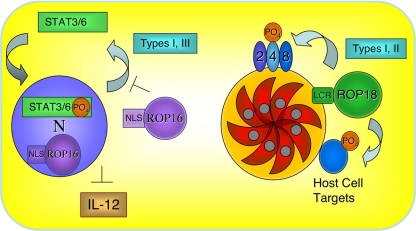FIG. 2.
Model for the proposed roles of ROP16 and ROP18. (Right) ROP18 is highly expressed in type I and II strains, and following secretion it is targeted to the PVM by a series of low-complexity helical regions (LCR) in the N terminus. ROP18 has been shown to phosphorylate other ROPs in vitro, suggesting that it may also perform this function in infected cells (i.e., ROP2, -4, and -8, as shown). Additionally, host cell proteins may be targets of ROP18. The virulence-enhancing potential of ROP18 requires kinase activity and has been associated with slightly enhanced growth. (Left) ROP16 is targeted to the host cell nucleus (N) by a nuclear localization sequence (NLS), although it may also be active in the cytosol. ROP16 from type I and III strains induces prolonged activation of STAT3/6, thus activating gene expression in the host cell nucleus but blocking the production of IL-12.

